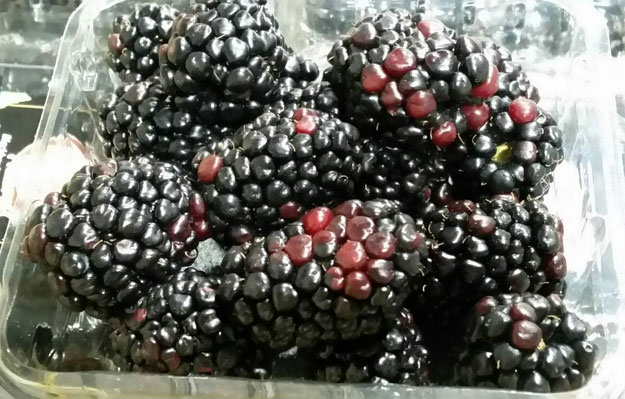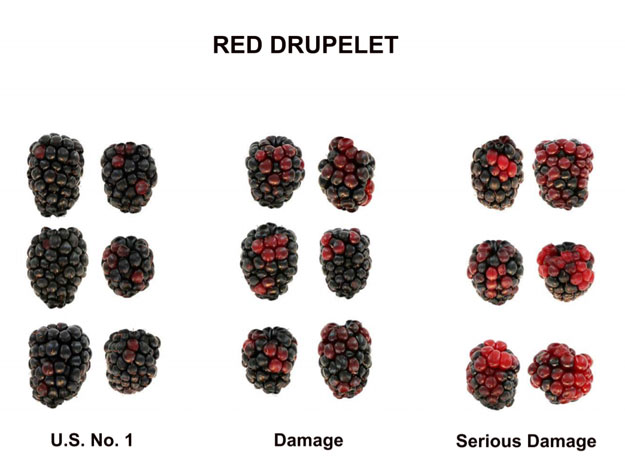Red Cell is the name given to the red color sometimes seen on Blackberries. This falls into the category of being somewhat controversial.

To be honest, I have seen this reddish color on blackberries for years and never scored this as a defect. I never had seen another USDA inspector score this as a defect either. At the USDA’s Training Center I was assigned to teach all USDA Inspectors nationwide on how to inspect strawberries and other berries and this topic never came up. And lastly, never have a retailer or wholesaler asked me to score this as a defect in all my years as a USDA inspector. Was I wrong all these years? Was the USDA wrong all these years?
Now, let’s move forward. During a recent training class for a major retailer a question was raised. How is “red cell” on blackberries scored or not scored as a defect? I immediately referenced the U.S. Grade Standard for Blackberries and found no reference to Red Cell, but the U.S. No. 1 Grade does require the blackberries be well colored. Well colored means, “that the whole surface of the berry shall be a blue or black color.” No red color is allowed.
Surprised by what I read, and contrary to what I had done, I reached out to the USDA to get an official response. To help clear this up the USDA has created an official visual aid to give the fresh produce industry a guide as to what is deemed acceptable, what is scored as a defect, as damage, or what would be considered as being scored as serious damage.

Do you think the USDA is correct in with their scoring guideline? As you can see from the visual aid, for those blackberries considered as U.S. No. 1, the USDA does goes against the grade standard and is allowing some red cells on the surface of the berry. Most QA’s I’ve met with do score red cell as a defect, but most score the defect as damage when it affects about 20% of the surface or more. No doubt about it, this visual will change the way some QA’s are currently scoring red cell as a defect.
Most people I have talked with believe the defect is caused by a cooling issue, not a coloring issue. Dr. Manuel Madrid states “The main reason for this defect is delays in cooling, that is, too long harvest to cooling times. Or breakdown of cold chain during transport ( for example, upper boxes in air cargo blackberries , exposed to hot temperatures on the Tarmac). Some varieties are more prone than others to this defect. If the cold chain is fast and intact, this problem is reduced to a minimum.” Dr. Madrid is not alone.

11 Comments on “Blackberries- Red Cell”
The explanation on the issue of red cel is not accurate. Red cel develop because genetic predisposition, hot fruit get cool to lower temperature( propose step cooling as a solution) and mineral unbalance in thye fruit, especially high amount of N. See University of Arkansas site with more on the subject.
https://www.uaex.edu/farm-ranch/crops-commercial-horticulture/horticulture/ar-fruit-veg-nut-update-blog/posts/fruitdisorders.aspx
Thanks for the comment, Miguel!
I have read at least 5 topics on the red on blackberries. I still have not found an answer to my search: Is it safe to eat blackberries after you purchase them and they start turning red????
Patricia, although the red on the blackberries may not be appealing, I have not heard that they are not safe to eat.
It doesn’t appear the U.S. standard has been changed. As the standard specifically states what color berries are supposed to be to meet the U.S. No. 1 grade (and the color red is not mentioned), how does the USDA inspection service get the authority to simply defy the standard? (I worked for the USDA for over 34 years, a few of those in fresh products standardization, and therefore know the only way the standards can be amended is at the industry’s request. USDA has no authority to unilaterally create a new or amend an existing standard).
Hi all. There´s certainly a genetic predisposition to Red drupelet reversion (RDR), although its not yet fully understood, it has been demonstrated that conditions of post-harvest storage and physical damage can result in RDR. What happens basically is that cellular structure changes due to the effect of associated factors (light, temperatura, vibration, etc) if a physical rupture of cells happen there is loss of cell-to-cell adhesion which likely responsible for the loss of firmness that ultimately causes exposure and degradation of anthocyanins. Anthocyanins color is pH sensitive. Damage to the cells accelerates their degradation which causes color change along with cell structural modifications. There should be no safety issues for eating RDR blackberries, although some of the organoleptic features might not be as appealing as fully black berries.
Joel, thanks for you comment. Much appreciated.
paul i believe the standard was updated at the industrys request mostly because as tyawman stated he never scored it and most inspectors were not scoring the defect either, and recievers were stuck to sell blackberries that looked red. although i personally have always believed this to be a condition defect mainly because i have had lots breakdown rather quickly in both cold storage and on display. the real confusion for me is if you consider the red to go against color you have a quality defect, if its scored as red druplet its condition? is this decision left up to the inspector? quality is always scored b4 condition except for decay correct? so if i request condition only will it not be scored? if i do grade and condition will paca side with or against me on the quality?
Brian, thanks for the comment. Paul’s point was the BlackBerry standard was never updated but the USDA made a change to the scoring guideline none the less. The new scoring guideline contradicts the standard.
Red drupelet has been deemed a “condition defect”. I’m assuming the contention is that affected blackberries were always well colored, thus not contradicting something that was in the standard. In the past USDA inspectors (most) would only score this defect as a quality defect (not well color) and ignore during condition only inspections.
Hi,
This defect as nothing to do with the cold chain.
If the Drupelets are soft can be Physiological, mainly due to extreme environment (high temperature and humidity) or Sucking bug damage (the drupelets will be small, red and dry)
If the drupelets are hard, the main cause is redberry mite.
Hope this help.
Thank for the information and pics.